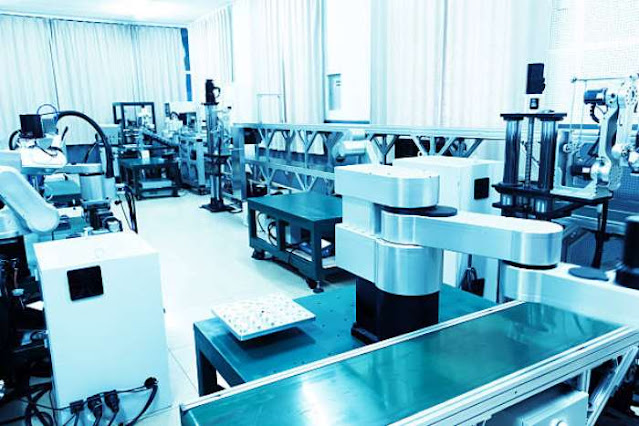
Conveyors have revolutionized industries by automating the
movement of goods and materials, streamlining processes, and enhancing
efficiency. These mechanical systems are designed to transport items from one
location to another, making them an indispensable component of various sectors,
from manufacturing to logistics. In this article, we'll delve into the
different types of conveyors and their applications across industries.
1. Belt Conveyors
Belt conveyors are perhaps the most well-known and widely
used type of conveyor system. They consist of a continuous belt that rotates
around two or more pulleys. Belt conveyors are versatile and can handle a wide
range of ingredients, from lightweight to heavy and from small to large. They
are commonly used in industries such as agriculture, mining, manufacturing, and
packaging.
Applications: Moving products on assembly lines,
transporting bulk materials, loading and unloading trucks, and more.
2. Roller Conveyors
Roller conveyors consist of a sequence of rollers mounted on
a frame. These rollers allow items to move along the conveyor, either manually
pushed or by gravity. Roller conveyors come in various configurations, such as
powered roller conveyors (motorized) and gravity roller conveyors (rely on
slopes for movement).
Applications: Warehousing, distribution centers, material
handling, and transporting packages of various sizes.
3. Screw Conveyors
Screw conveyors, also known as auger conveyors, utilize a revolving
helical screw blade to move materials. The materials are pushed forward through
the conveyor as the screw rotates. These conveyors are particularly effective
for transporting bulk materials, liquids, and granular substances.
Applications: Agriculture (moving grains and seeds), food
processing (transporting bulk ingredients), wastewater treatment (moving
sludge), and more.
4. Chain Conveyors
Chain conveyors use chains to move items along a track. They
are durable and well-suited for heavy-duty applications. Chain conveyors can be
powered by electric motors or run using manual force, depending on the specific
design.
Applications: Automotive industry (assembly lines),
warehouses (moving heavy loads), and manufacturing (conveying heavy products).
5. Pneumatic Conveyors
Pneumatic conveyors transport materials using air pressure
or vacuum. They are especially useful for moving fine powders, granules, and
other materials that might be damaged by other types of conveyors. Pneumatic
conveyors are flexible and can cover long distances.
Applications: Food industry (conveying flour, sugar, etc.),
pharmaceuticals (moving powders), and chemical manufacturing (handling
sensitive materials).
6. Vibrating Conveyors
Vibrating conveyors use vibrations to move materials along a
trough or other enclosed structure. These conveyors are commonly used for bulk
material handling and can convey materials horizontally, vertically, or on an
incline.
Applications: Recycling (moving scrap metal), mining
(conveying ores), and food processing (moving delicate items).
7. Overhead Conveyors
Overhead conveyors are suspended from the ceiling or
elevated structure, allowing items to move above ground level. These conveyors
are useful when floor space is limited or when items need to be transported
over obstacles.
Applications: Automotive painting lines, garment factories
(moving clothes for drying or storage), and warehouses.
8. Magnetic Conveyors
Magnetic conveyors use magnets to move ferrous materials
along a conveyor belt. The magnetic force helps hold the materials in place
during conveyance, reducing the risk of spills and ensuring efficient movement.
Applications: Recycling (sorting metal scrap), metalworking
(moving metal parts), and manufacturing (conveying metal products).
9. Bucket Conveyors
Bucket conveyors use buckets or cups attached to a chain or
belt to transport bulk materials vertically or horizontally. These conveyors
are often used for lifting materials to different levels or for transferring
materials between processes.
Applications: Agriculture (moving grains), construction
(conveying construction materials), and industrial processes (transferring
materials between production stages).
10. Slat Conveyors
Slat conveyors consist of slats or flat plates connected by
chains. They are particularly useful for carrying heavy loads or items that
might damage other types of conveyors.
Applications: Bottling plants (moving bottles), automotive
manufacturing (conveying car parts), and heavy equipment assembly lines.
Conclusion
Conveyors are the unsung heroes of various industries,
quietly and efficiently transporting materials and products to where they're
needed. Each type of conveyor brings its unique advantages and characteristics,
catering to the specific needs of different industries and applications. From
the versatility of belt conveyors to the precision of magnetic conveyors, the
world of conveyors is diverse and dynamic, continuously shaping the way goods
and materials move in modern society. As technology advances, we can imagine to
see even more innovative conveyor systems that further optimize processes and
contribute to increased efficiency across industries.
Comments
Post a Comment